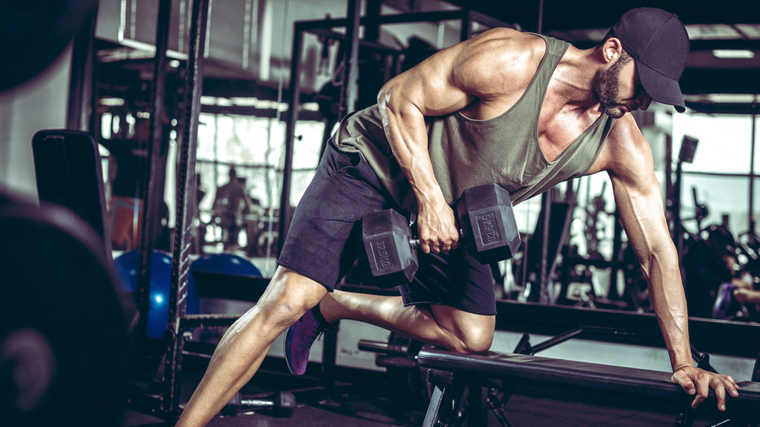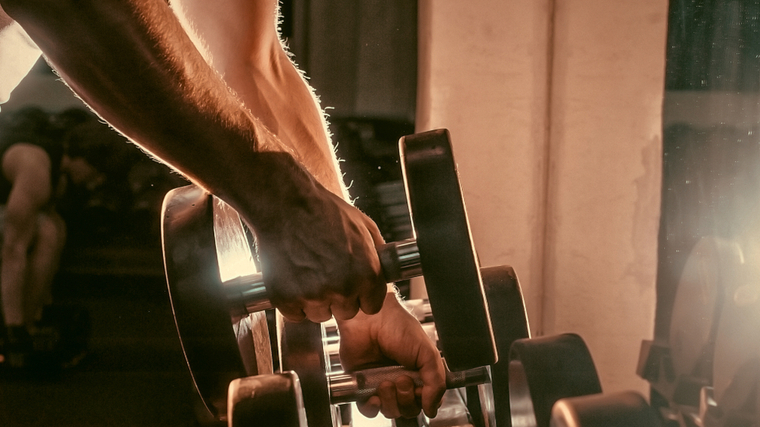The amount of muscles that make up the back provide a diverse variety of options for how you can structure your workouts. Given that there are so many unique ways to attack your back, you might actually have some gaps in your physique or strength development if you work exclusively with the barbell or use too many machines.
Enter the trusty dumbbell to cover the spread. Dumbbells bring all the intensity of heavy free-weight work but allow you to customize and tailor your training to your specific body structure.

Needless to say, a well-trained back is important for every fitness goal. With dumbbells, there’s really nothing left off the table — here are the five best dumbbell back workouts for you to dive into.
Best Dumbbell Back Workouts
- Dumbbell Back Workout for Strength
- Dumbbell Back Workout for Building Muscle
- Dumbbell Back Workout With a Single Dumbbell
- Dumbbell Back Workout for Conditioning
- Dumbbell Back Workout for Endurance
Best Dumbbell Back Workout for Strength
When working with dumbbells, you should try to include a full-body integrated exercise to hit the back as a unit. Once that’s been covered, train as heavily as possible while isolating as many of the major muscle groups as you can. You can achieve this by changing the angle of pull and manipulating grip positions or elbow angles. On that note, grip strength or endurance may play a factor in how heavy you can go, so keep some straps at the ready if your hands start to limit your strength.
The Workout
A bent-over dumbbell row should be the cornerstone of your dumbbell back strength workout. Regardless of the specific angle you take, the hinged posture is going to recruit the core and spinal erectors as assisting muscle groups, helping to strengthen the full body. Since dumbbells are the focus here, a single-arm dumbbell row is a great choice.
- Single-Arm Dumbbell Row: 3×6-8
- Chest-Supported Dumbbell Row: 3×6-8
- Dumbbell Bent-Over Y-Raise: 3×10
- Dumbbell Rear-Delt Row: 3×10
Best Dumbbell back Workout for Building Muscle
Hypertrophy workouts for your back should really emphasize different angles and ranges of motion to best prioritize each individual muscle. In order to achieve this (and coincidentally build muscle), drop the weight a smidge and focus on medium to higher repetitions. This way the smaller muscle groups can still receive their specific overload without being overwhelmed. More sets or exercises per workout can also help chisel out each individual muscle.
The Workout
There are a few muscles that act quite synergistically, meaning that they will receive some muscle-building benefits between several different exercises. Keep the elbow closer to the body to target the latissimus dorsi on your dumbbell rows, or flare it out slightly to target your trapezius and rhomboids.
It’s also easier to distinguish between targeting the trapezius and rhomboids by using the right amount of weight for each muscle. Too much weight can be a deal-breaker for the rhomboids, leading to too much trapezius involvement. Make sure you have good technique before loading up on weight.
- Single-Arm Dumbbell Row: 4×10-12
- Dumbbell Seal Row: 3×12
- Chest-Supported Dumbbell Row: 3×15
- Dumbbell Pullover: 3×12
- Dumbbell Reverse Fly: 3×15
Best Dumbbell Back Workout With a Single Dumbbell
Limited equipment isn’t an unrealistic scenario, especially in the age of at-home workouts. What happens when you have a limited amount of load? Pile everything you have on a single weight and go to town. Single-dumbbell back workouts can still be very effective for building strength, muscle, and most importantly, core stability. The unilateral nature of every exercise will certainly help you build an iron brace.
The Workout
The single-arm dumbbell row shows its versatility here, allowing a bedrock of strength or muscle building stimulus for the lats or trapezius and rhomboids depending on how you choose to angle your elbow. Use it to establish the foundation of the workout – overloading the muscle while using the opposing hand to stabilize against a dumbbell rack, bench, or anything else you can think of. From there, taking away the anchor point of the bench will help you get the most out of the limited loading potential by heavily challenging your core stability.
- Dumbbell Row: 3×8-10
- Bent-Over Single-Arm Reverse Fly: 3×12-15
- Single-Arm Dumbbell I-Y-T: 3×10 per position.
- Tempo Dumbbell Pullover*: 3×10
Note: For the pullovers, take a full three seconds to lower the weight under control.

Best Dumbbell Back Workout For Conditioning
Conditioning with dumbbells is a great option because the unilateral aspect of the resistance necessitates a ton of coordination and core engagement. This will help amplify the difficulty and crank your heart rate that much more. The trick is to have multiple sets of dumbbells at the ready to accommodate your fatigue accumulation and to scale things down as you get tired. Start with full-body exercises before progressing to more isolated or stable options as you fatigue throughout the circuit.
The Workout
Conditioning can fall into many categories, but most applicable to dumbbell training would be higher intensity circuit training. Line up a few convenient exercises to keep transit time low and to maintain a high heart rate. Performing a specific amount of rounds of a circuit or an AMRAP (as many rounds as possible) within a given time period are great ways to get a killer conditioning workout in.
Hit this circuit for as many rounds as you can complete within 30 minutes with minimal rest between rounds.
- Bent-Over Dumbbell Row: 1×10
- Renegade Row: 1×10 per arm.
- Single-Arm Dumbbell Row: 1×12
- Flared-Elbow Seal Row: 1×15
- Chest-Supported Dumbbell Reverse Flye: 1×15
Best Dumbbell Back Workout For Endurance
Training for muscular endurance is pretty similar to working on gaining size, except that you’re aiming to hit failure with much higher repetitions overall — think as high as 15 to 20 reps or more. This requires lesser loading overall, which tangentially allows you to single out and isolate certain muscles. Further, high-rep work gives you ample time to fine-tune your mind-muscle connection.
The Workout
The idea behind endurance workouts is to light the muscle on fire and effectively keep it that way for the duration of the workout. Rest periods will be limited to about 30-45 seconds and repetitions much higher than other training styles. Load should be reduced to accommodate, but endurance workouts are by no means easy.
- Bent-Over Row: 4×15-20
- Single-Arm Dumbbell Rear-Delt Row: 3×20
- Flared-Elbow Seal Row: 3x as many repetitions as possible.
- Chest-Supported Dumbbell Y-Raise: 2×20
Benefits of Working with Dumbbells
Dumbbells are a great tool for creating back workouts. Each muscle in your back requires subtle differences in grip orientation and elbow angle that are hard (if not impossible) to achieve with most other implements. Improved individual muscle group isolation, balancing any asymmetry in strength or muscular development, and individualizing exercises to your own unique structure are huge assets in this field.
Unilateral Balance
Dumbbells provide the unique opportunity to check in on your muscle strength, coordination, and joint stability differences that might be developing between each side of the body. Where barbells and machines may mask this, dumbbells prevent one limb from compensating for the other. The test is also the solution, for any discrepancies found, using dumbbells or other unilateral exercises will be the path back to symmetry.

Individual Anatomy
Your individual limb lengths, muscle origin/insertion points, and leverages are unique to you. All of these landmarks have implications on how to best isolate each muscle of the back, but also, may contribute to a plateau if you don’t customize your training.
Think of trying to force a square peg into a round hole. Machines and barbells are designed to perform a specific task or have less wiggle room for individual differences. Dumbbells help account for your anatomically-unique features to make your training more efficient.
Improved Isolation
Effectively training your back requires a combination of proper load selection, grip orientations, and elbow angles. Each of these choices has an impact on which muscle of the back will be biased during any given exercise — for example, a barbell row versus a dumbbell row.
The barbell row is largely a fixed motion, meaning that there’s only so much wiggle room for your lats to contract in. The customizability of dumbbell positioning easily accommodates any number of grip and elbow angle orientations to best target your preferred muscle with better isolation.
Anatomy of the Back
The deeper understanding of back anatomy that you walk into your workouts with, the better you will understand how to perform each exercise. Knowing the origin and insertion (where your muscle attaches to each part of your body) will help you make choices about your grip, elbow angle, load management, sets, and repetitions much easier to determine as well. Training the back is all about drawing the arm from in front of the body to behind it — knowing your anatomy helps guide the finer details.
Trapezius
The trapezius muscle (or traps) are one of the larger muscles of the back. The middle and lower traps originate and insert along the C7-T12 vertebrae to the lateral third of the clavicle, the acromion process, and the spine of the scapula. Exercises that target these areas of the traps most effectively will typically have a wider arm angle and aim to pull the shoulder blades together.
Latissimus Dorsi
The latissimus dorsi, or lats, are wide muscles found along either side of the torso. They span a wide range of origin and insertion points from the spinous processes of the T7-L5 ribs, thoracolumbar fascia, iliac crest, and inferior angle of the scapula to the intertubercular groove of the humerus (upper arm). Given these origin and insertion points, exercises that draw the arm from in front of the body towards a retracted position will all be beneficial for targeting the lats.
Rear Deltoid
Although the rear deltoids can be trained as a part of a shoulder day, they are also found on the backside of the body and can be synergistically trained with many back movements. Many exercises that target the traps and lats will also stimulate the rear deltoids, especially as the arm travels further behind the midline of the body.
Rhomboids
The rhomboids are found between the spinous processes of T2-T5 and the medial border of the scapula, meaning that they play a key role in retracting the shoulder blades. Exercises that move your shoulder blades from fully protracted to fully retracted will help stimulate the rhomboids.
Spinal Erectors
The spinal erectors are worth mentioning as part of your back. They do contribute to the overall aesthetic of the upper back, and usually react and contract against any forces trying to flex the spine. This means that using unsupported exercises such as a bent-over row will help develop them over time as they are constantly engaged as a part of the core muscle group preventing your back from rounding.
Wrapping Up
The sheer amount of muscles and exercises that a good back workout can draw upon provides endless variability and creativity. With a bit of knowledge on how to arrange the body, a great deal of specific strength, muscle growth, or endurance are all on offer — especially with the added spiciness of dumbbells thrown into the equation.
With their unique ability to conform to the needs of your body and goals, dumbbell back workouts are the obvious choice to prevent plateaus, address muscle imbalances, and stave off boredom all at once. Grab a pair of dumbbells on your next workout and go to town, your back will thank you.
Featured Image: Ajan Alen / Shutterstock